| |  | | | | |
| Process
Technology |
Darjeeling
teas are still manufactured using old
industrial techniques developed in the
late 1800's. These traditional methods
are collectively termed as 'Orthodox Production'.
By these methods Darjeeling teas are produced
without 'cut & crush' of tender tea leaves
maintaining the inherent Darjeeling tea
aroma. Although differing leaf varieties
require intricate variations in processing,
the stages undergone are uniform. With
the advancement in technology the orthodox
procedures are gradually being replaced
by highly mechanized methods with their
primary focus on yields. But in Darjeeling
hills 'Quality' is the primary focus and
it is never compromised with the quantity.
Darjeeling tea planter is still producing
the finest teas of the world using these
orthodox methods with utmost attention
on the process. Of late, few gardens are
changed to green tea manufacture especially
during the rainy season thus producing
the finest quality of flavoury green teas.
|
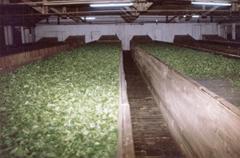 |
Withering:
It is the first stage of tea manufacture. During withering harvested tea flush is evenly spread on the withering troughs which are normally 4 to 5 feet wide and 50 to 70 ft long. During the process hot and cold air is blown through to remove the moisture of fresh leaf to 30-40 percent which is achieved during 16 to 18 hours of period. The prime object of withering is to make the turgid leaf flaccid and prepare the leaf for next stage to facilitate rolling. |
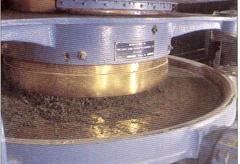 |
Rolling:
The withered leaf is charged in the rollers
which vary in size. Normally they are
36" and 48" rollers capable of rolling
70 to 120 kg of withered leaf. The pressure
is exerted on the leaf in 'open and pressure'
sequence. This operation lasts for 45
minutes. During this process tea leaf
is twisted as a result of repeated rolling
action and simultaneously leaf tissue
ruptures thus forcing out the cell-sap
which spreads as a this film on the surface
of the leaf. Various enzymes and their
substrates come in contact and enzymatic
oxidation starts at this stage. The green
colour of leaf starts diminishing and
brown coppery colour of leaf begins to
appear. |
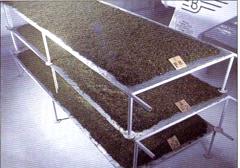 |
Fermentation:
Rolled leaf is put on fermentation
racks specially made of tiles, cement
or aluminium. Fermentation rooms are kept
clean and cold. In Darjeeling fermentation
is carried out at low temperature. In
hot season the air is kept humid with
the help of humidifiers with less than
200c hygrometric difference
Optimum fermentation is adjudged by the
subjective assessment of the tea maker.
Fermentation period varies from 2 to 3
hrs depending on the type of leaf, degree
of wither, temperature, availability of
oxygen and fermenting ability of the tea
flush. The time of fermentation is reckoned
from the time at which rolling begins.
Fermentation is a very sensitive process.
Even 5 minutes time delay in adjusting
the correct fermentation period is likely
to deteriorate flavour appreciably. During
fermentation the leaf changes colour and
becomes dark coppery. A typical aroma
develops at this stage. The term 'Fermentation'
is a misnomer and, in fact, it is an oxidative
process. Oxidation of catechin / polyphenols
by the enzyme polyphenol oxidase is the
main reaction of the process that imparts
'tea character' to the black tea. |
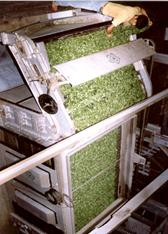 |
Firing
/ Drying:
Fermented leaf is loaded onto the dryer,
which comprises perforated moving trays.
The dryer inlet temperature is maintained
at 200 to 2400F. Thickness
of spread, speed of trays and volume of
air blown through are regulated meticulously
so as to achieve the correct drying. Low
exhust temperature often produces stewed
teas while high temperature in the initial
stages is apt to case-hardening of teas.
The whole process of drying is completed
within 20 to 30 minutes. The moisture
content of the final product in Darjeeling
teas is kept at 2 to 3 percent. Darjeeling
teas are normally fired at high temperature
which is considered essential for squeezing
the correct balance of volatile flavoury
compounds in high quality teas. During
the drying process enzymes responsible
for fermentation are inactivated and even
after the tea is dry the maturation process
continues and tea attains the mellowness
a desirable character of Darjeeling teas. |
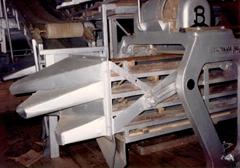 |
Sorting
& Grading:
The bulk tea is sorted on mechanically
oscillated sieves. The sieve size decreases
gradually from top to bottom. Thus the
bigger size teas are retained on the top
while the brokenm leaves fall towards
the floor. | |
| |
| |
|
|
|